Michigan wasn’t nicknamed The Great Lake State for nothing! It’s the only state to border Lake Superior, Lake Huron, and Lake Michigan, and this watery world offers a rich habitat for a variety of birds.
Among the 400+ bird species that have been recorded in Michigan, I’ve counted 17 sparrow species that reside in the state at certain times of the year, as well as two more that can be seen passing through the state during the migration seasons.
Because of its northerly position, Michigan is more of a breeding territory for most sparrow species. Nevertheless, a few of the hardier species do remain here year-round, and there’s even one extraordinary sparrow that’s found in Michigan exclusively during the winter (can you guess which it is?).
Whether you’re a Michigan resident, or just passing through on a birdwatching or hiking trip, sparrows are a fascinating family to get to know better. Here, we’ll be taking a closer look at each species so you know where to look and how to distinguish each species from its relatives.
Top Species of Sparrows in Michigan, Beginning With the Most Common
Song Sparrow

- Scientific Name: Melospiza melodia
- Length: 4.7-6.7 in (12-17 cm)
- Weight: 0.4-1.9 oz (12-53 g)
- Wingspan: 7.1-9.4 in (18-24 cm)
According to bird watcher’s reports, song sparrows are the most frequently spotted sparrow in the USA, and they are also the most commonly seen in Michigan.
The appearance of these medium-sized sparrows can easily be confused with many other species, but it’s their constant song that, once learned, makes them easy to identify.
Song sparrows are primarily summer residents in Michigan when huge numbers of them breed in the state, but small populations can be found in the south of Michigan during the winter, too.
During the colder months, you can easily attract these noisy sparrows to your backyard bird feeder by offering them cracked corn, black oil sunflower seeds, and other nutritious grains.
House Sparrow
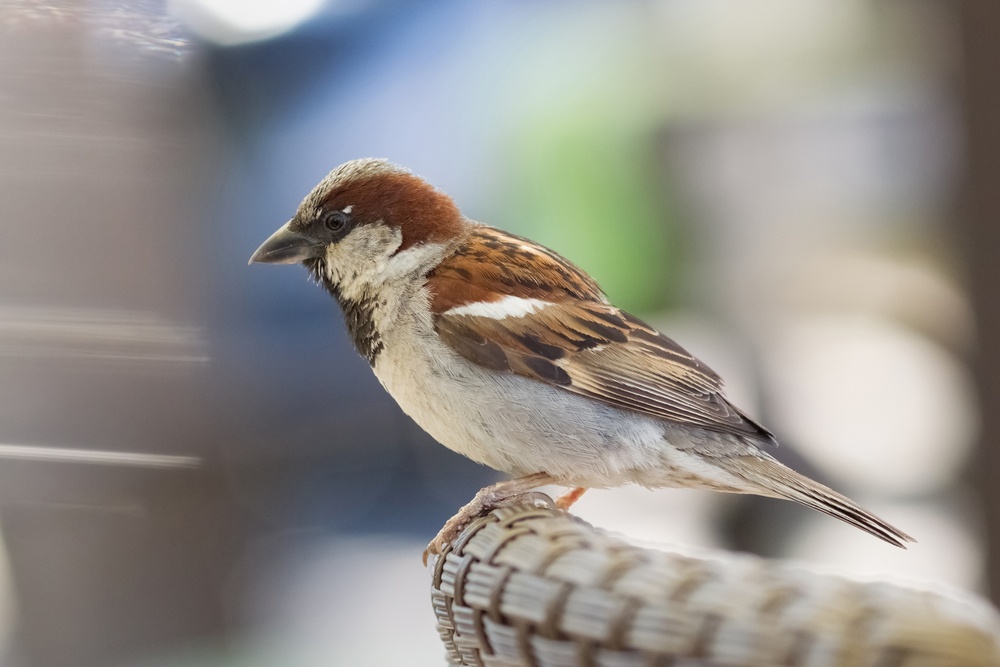
- Scientific Name: Passer domesticus
- Length: 5.9-6.7 in (15-17 cm)
- Weight: 0.9-1.1 oz (27-30 g)
- Wingspan: 7.5-9.8 in (19-25 cm)
Did you know that the ubiquitous house sparrow isn’t native to America? They were brought to New York in 1852 by European settlers to control insect pests, but their populations exploded and they were soon to be seen across the entire country.
Although less common than they once were, house sparrows are the second most common sparrow in the United States, and the second most reported in Michigan, too. Their presence sometimes concerns ornithologists, since these assertive sparrows often take over the nesting grounds of native bird species.
House sparrows belong to a different family to native American sparrows and they also behave rather differently. Rather than migrating, house sparrows stay within the same territories year-round, typically near human habitation.
Despite their status as an invasive species, the cheerful house sparrow is loved by many. As one the tamest of all backyard birds, they can even be trained to eat out of your hand!
Dark-eyed Junco
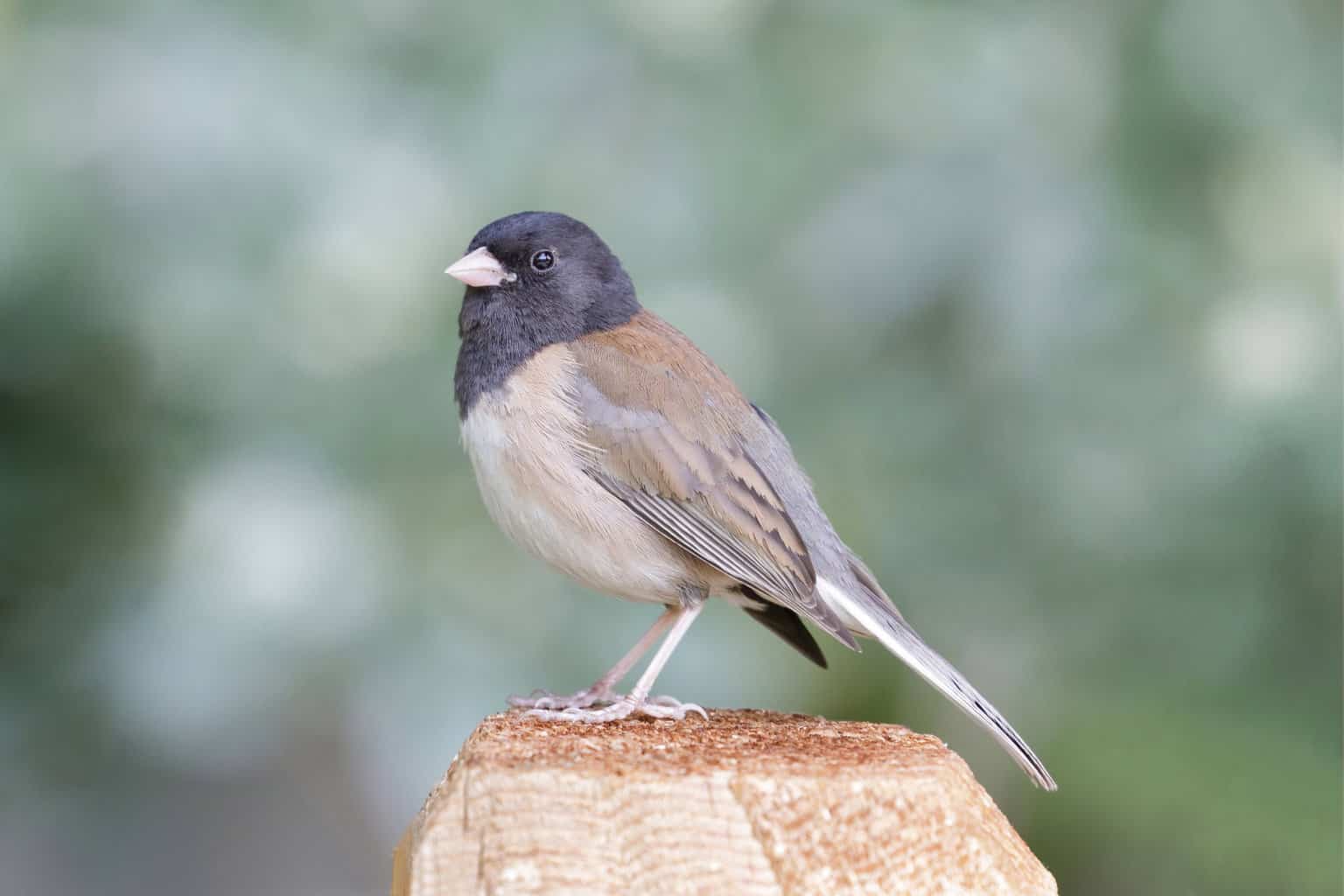
- Scientific Name: Junco hyemalis
- Length: 5.5-6.3 in (14-16 cm)
- Weight: 0.6-1.1 oz (18-30 g)
- Wingspan: 7.1-9.8 in (18-25 cm)
Although there are various sub-species of dark-eyed juncos across the United States, the ones that you’ll see in Michigan will almost always be the ‘slate-colored’ variety. The males are well-described by this name, although females tend to display various shades of brown plumage, too.
Dark-eyed juncos are sometimes known as ‘snow birds’ because they appear to be so hardy. They are one of the few sparrows that you can find throughout Michigan in the winter months, and some of them remain to breed in the northern half of the state, too.
You can easily attract these common birds to your backyard during the winter by offering them bird food such as peanuts and mixed seeds from your seed feeder.
Note that the very different-looking Oregon dark-eyed junco is an extremely rare vagrant here, but might occasionally surprise bird watchers with their unexpected appearance!
Chipping Sparrow
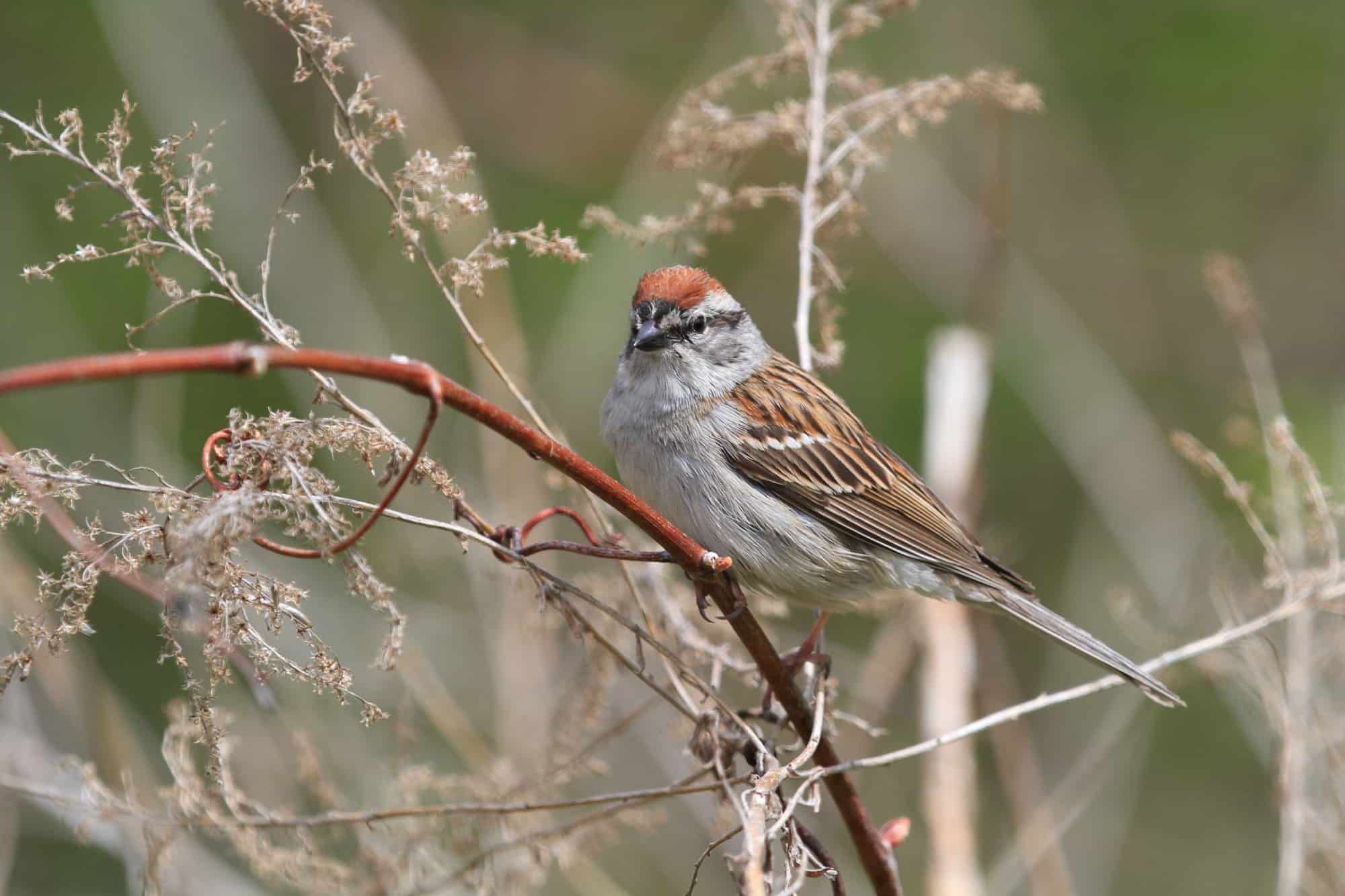
- Scientific Name: Spizella passerina
- Length: 4.7-5.9 in (12-15 cm)
- Weight: 0.4-0.6 oz (11-16 g)
- Wingspan: 8.3 in (21 cm)
Chipping sparrows can be recognized by their bright, rusty crown feathers, black eye lines, and gray chests. They are also fairly noisy birds, so it’s worth getting to know their different calls if you want to identify them reliably.
More of a southerly species than the above sparrows, chipping sparrows can only be found in Michigan during the breeding season when they can be found throughout the state, busy nesting in open woodlands.
In winter, most individuals of this common sparrow fly to more southerly states and even Central America.
American Tree Sparrow
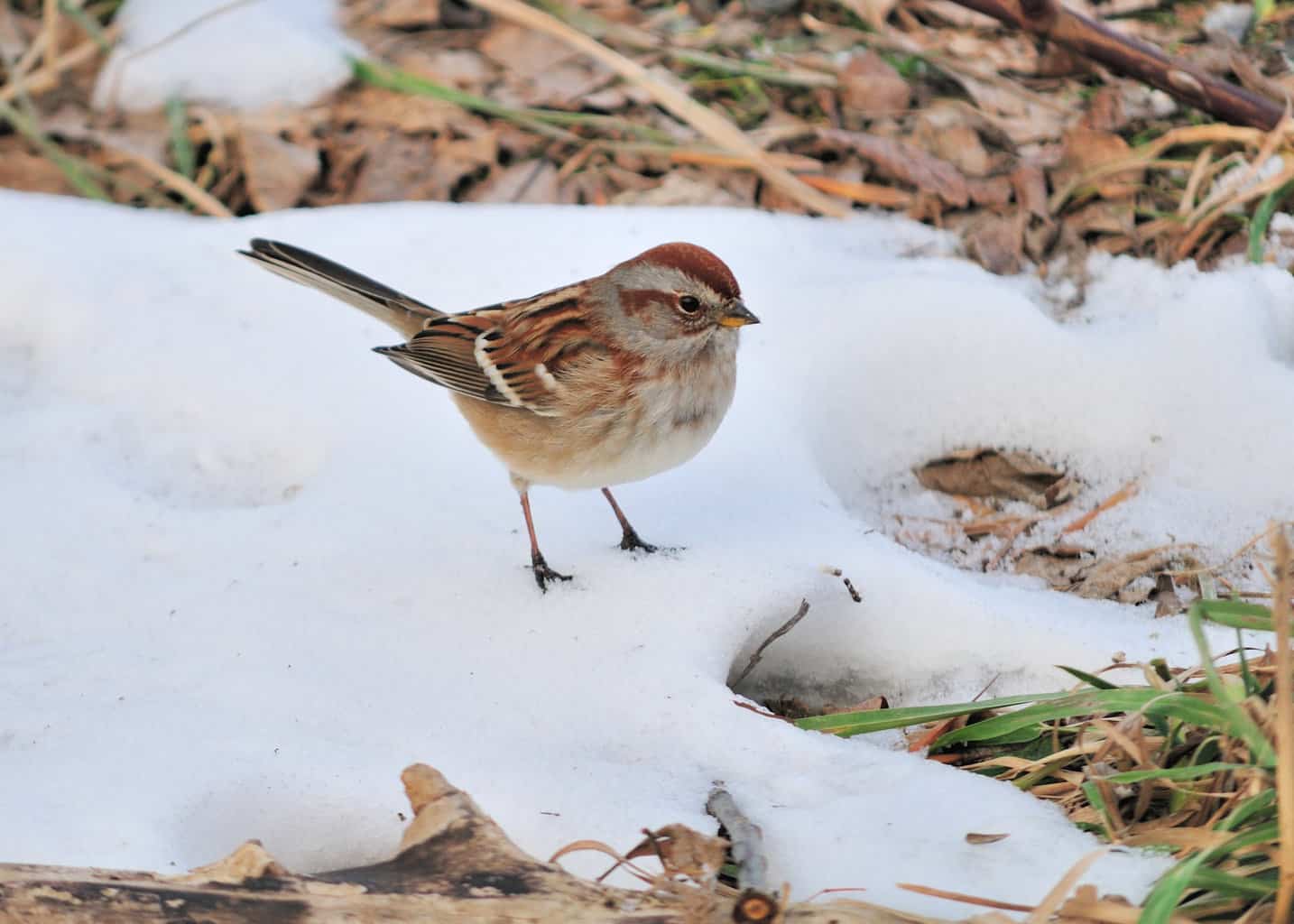
- Scientific Name: Spizelloides arborea
- Length: 5.5 in (14 cm)
- Weight: 0.5-1.0 oz (13-28 g)
- Wingspan: 9.4 in (24 cm)
Despite their name, tree sparrows are normally found near the ground. The misnomer about their habitat is due to their title having been decided by early settlers who simply named this sparrow after their native Eurasian tree sparrows which have a superficial resemblance.
American tree sparrows are most easily recognized by their rufous crowns and eye lines set against an otherwise gray head and throat. They’re slightly larger than the similar-looking field sparrow.
As far as my research has shown me, the American tree sparrow is the only New World Sparrow that resides in Michigan exclusively during the winter. This just goes to show how hardy these tundra birds are – they breed exclusively in the far north of Canada and Alaska!
White-throated Sparrow
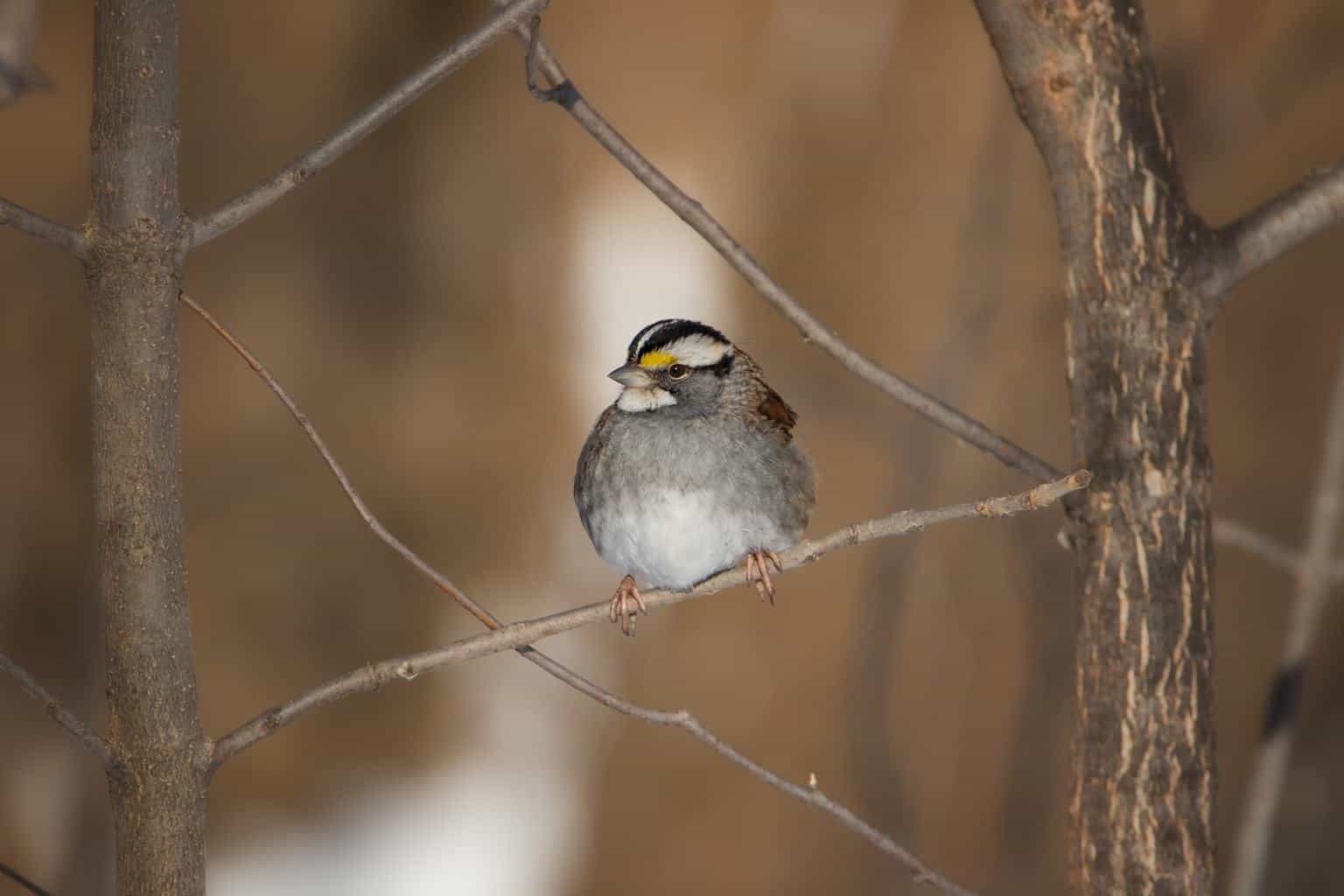
- Scientific Name: Zonotrichia albicollis
- Length: 6.3-7.1 in (16-18 cm)
- Weight: 0.8-1.1 oz (22-32 g)
- Wingspan: 7.9-9.1 in (20-23 cm)
White-throated sparrows are fairly easily recognized by their black and white/tan striped heads and yellow eyebrows. They also have a distinctive, rather mournful whistle that’s fun to impersonate!
This common backyard bird only breeds in the northern half of Michigan. You’ll only tend to see them in the south of the state during their annual migration, except, perhaps, for a few sightings in mild winters near the border with Indiana and Ohio.
Nests are built by females from moss and twigs, and lined with soft materials such as grass and animal hair. Like many sparrows, this species tend to nest on or near the ground, among dense vegetation.
Eastern Towhee

- Scientific Name: Pipilo erythrophthalmus
- Length: 6.8-8.2 in (17.3-20.8 cm)
- Weight: 1.1-1.8 oz (32-52 g)
- Wingspan: 7.9-11.0 in (20-28 cm)
They might not look or sound like a sparrow, but the eastern towhee is very much part of the North American or ‘New World’ sparrow family. These beautiful birds have a black head, wings, and tail, dark, ruby red eyes, rusty red flanks, and a white belly.
While eastern towhees are some of the most common sparrow species in more southerly states, they’re only seen by around 10% of bird watchers in Michigan during the breeding season. Interestingly, a tiny pocket of southeastern Michigan also hosts a winter population.
Look out for eastern towhees scratching about in the undergrowth for nuts, seeds, snails, millipedes, and insects.
Swamp Sparrow
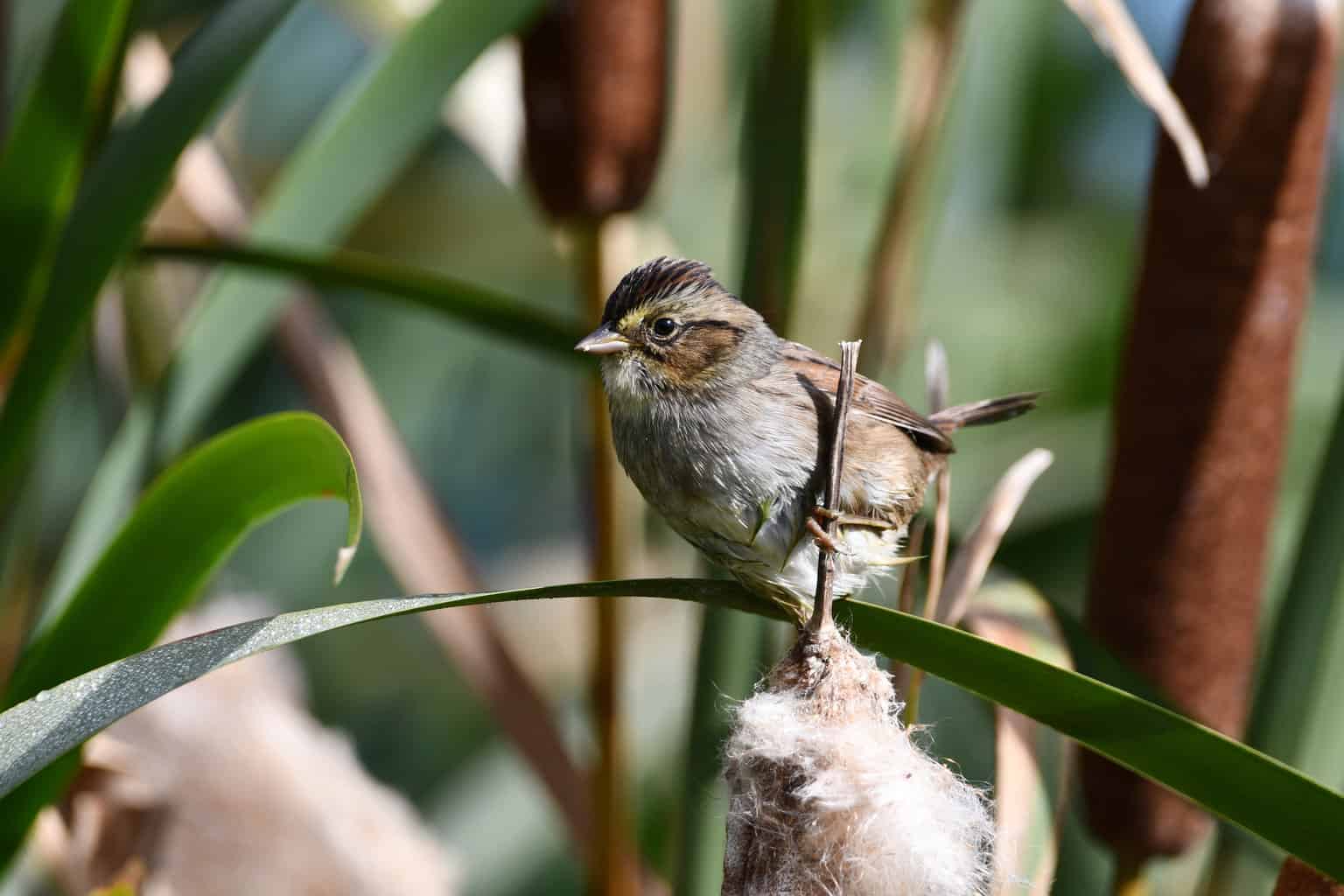
- Scientific Name: Melospiza georgiana
- Length: 4.7-5.9 in (12-15 cm)
- Weight: 0.5-0.8 oz (15-23 g)
- Wingspan: 7.1-7.5 in (18-19 cm)
The tiny, dark, and secretive swamp sparrow is a difficult bird to spot and identify, but their laugh-like, high pitch trill of notes is a good way to locate and recognize them.
Since swamp sparrows love water, they’re right at home in the watery landscapes of Michigan. The state boasts a strong population of these cute birds during the summer months when they nest among swamp and wetland vegetation.
Interestingly, the southern border of the state also marks the northern tip of their wintering range, meaning it’s sometimes possible to see swamp sparrows in Michigan year-round.
Swamp sparrows can also occasionally be attracted to backyards by offering them a bird bath.
Field Sparrow
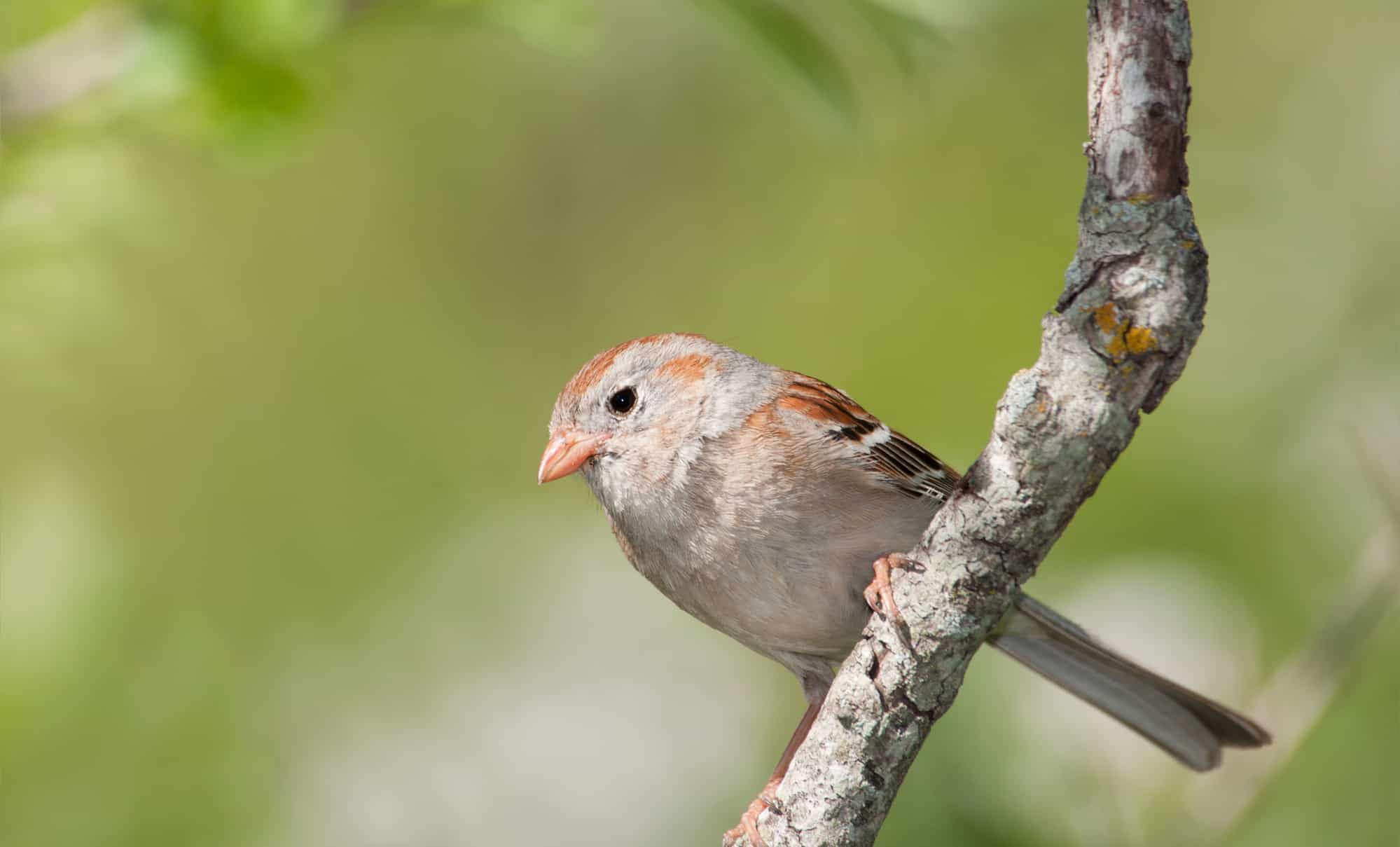
- Scientific Name: Spizella pusilla
- Length: 4.7-5.9 in (12-15 cm)
- Weight: 0.4-0.5 oz (11-15 g)
- Wingspan: 7.9 in (20 cm)
Field sparrows are closely related to American tree sparrows, but eastern populations tend to be more of a pink-reddish color. They can be told apart from similar-looking species by their loud, high-pitched call that sounds bizarrely like a metallic bouncing ball coming to a stop!
The relatively southern-dwelling field sparrow is a common sight in Michigan’s lower peninsula during the breeding season but is rarely seen in the state’s upper peninsula at all. They overwinter in the southeast of the US, as well as northern Mexico.
Field sparrows nest on the ground and, once hatched, their young only take about one week to fledge! Although they are common, their numbers are declining, probably due to the loss of weedy fields that they enjoy inhabiting.
White-crowned Sparrow
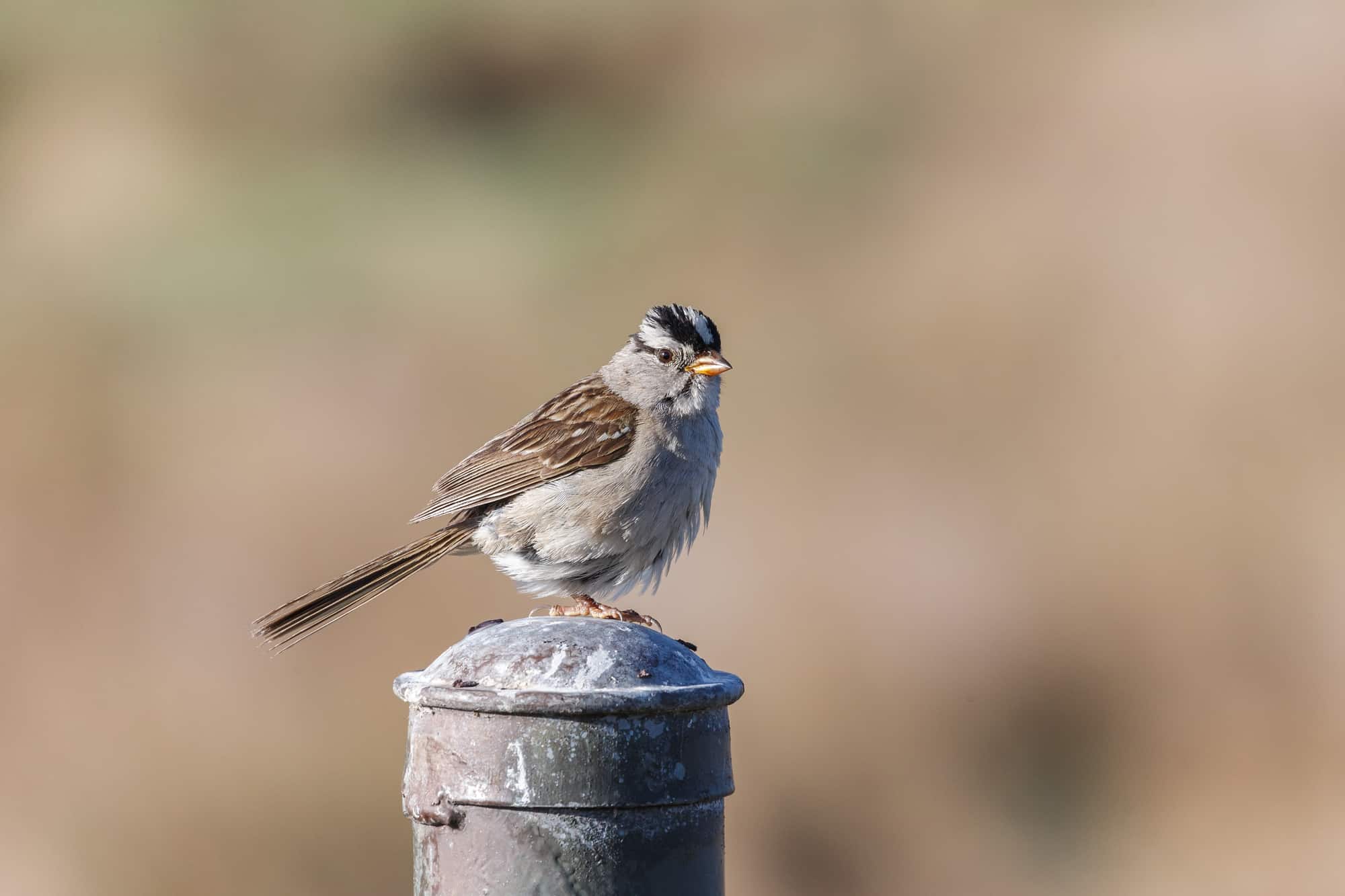
- Scientific Name: Zonotrichia leucophrys
- Length: 5.9-6.3 in (15-16 cm)
- Weight: 0.9-1.0 oz (25-28 g)
- Wingspan: 8.3-9.4 in (21-24 cm)
A larger-than-average member of the family, the white-crowned sparrow is fairly easy to identify by the black and white stripes on their crowns, and their yellowish bill.
Although a common sparrow in other parts of North America, the white-crowned sparrow is only seen in the majority of Michigan during the migratory seasons.
The south of the state represents the northernmost point of this bird’s winter range, so you’ll only see them occasionally along the border with Ohio and Indiana during the colder months.
Since large numbers of them pass through the state in the spring and fall, you might have success attracting these birds to your backyard feeder for a refuel during their long-distance flights!
Savannah Sparrow
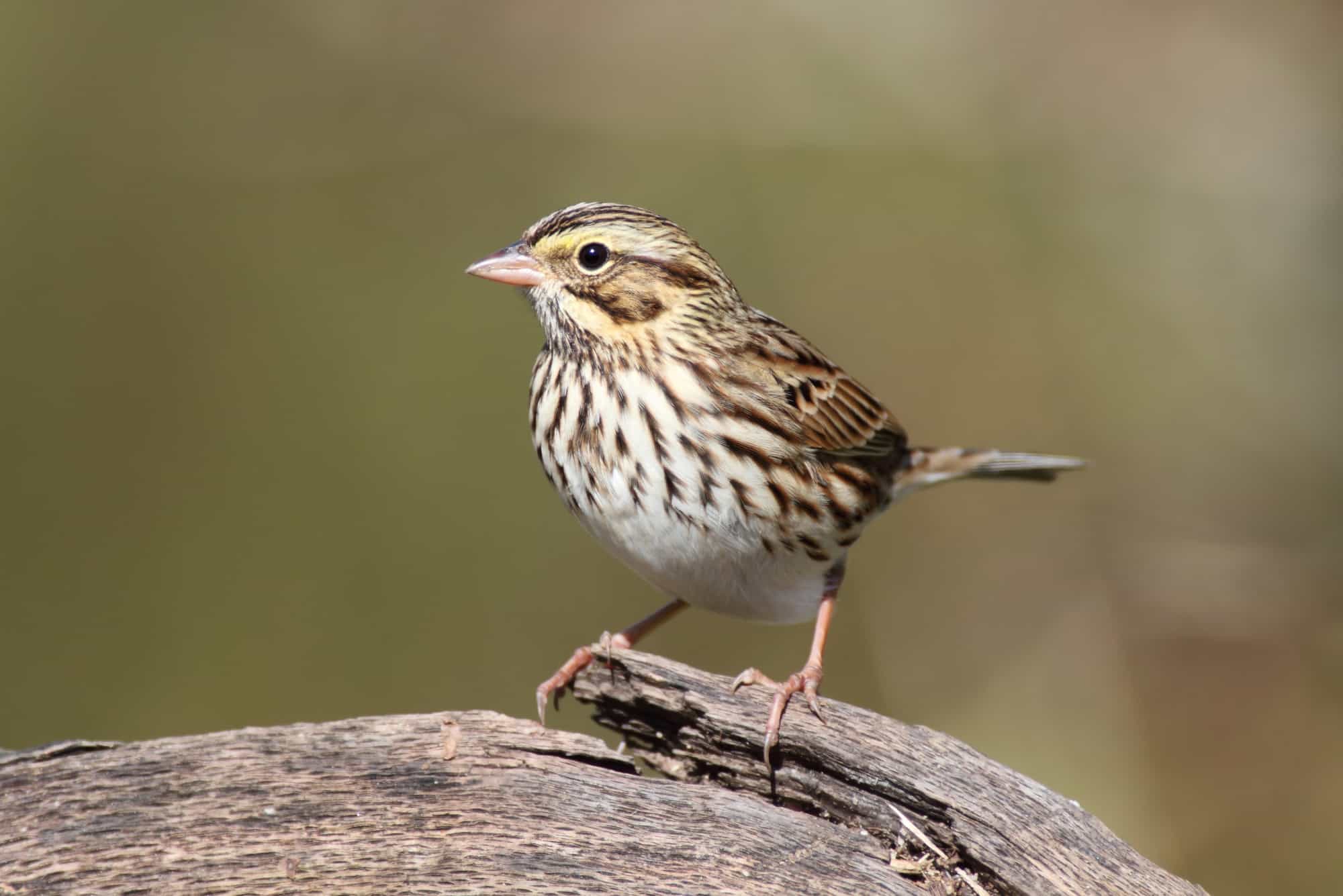
- Scientific Name: Passerculus sandwichensis
- Length: 4.3-5.9 in (11-15 cm)
- Weight: 0.5-1.0 oz (15-28 g)
- Wingspan: 7.9-8.7 in (20-22 cm)
Savannah sparrows are untamed grassland birds that tend to stay away from human habitation. Although they look rather like song sparrows, they can be differentiated with a pair of binoculars by the yellow wash around their face.
Savannah sparrows are only present in Michigan during the breeding season when they can be found throughout the state. They build their nests on the ground out of grass, and their young take between 1-2 weeks to fledge.
These medium-large sparrows are one of the most common sparrow species of open grasslands. You’ll often see them either perched on top of dead weed stems or on fences.
Vesper Sparrow
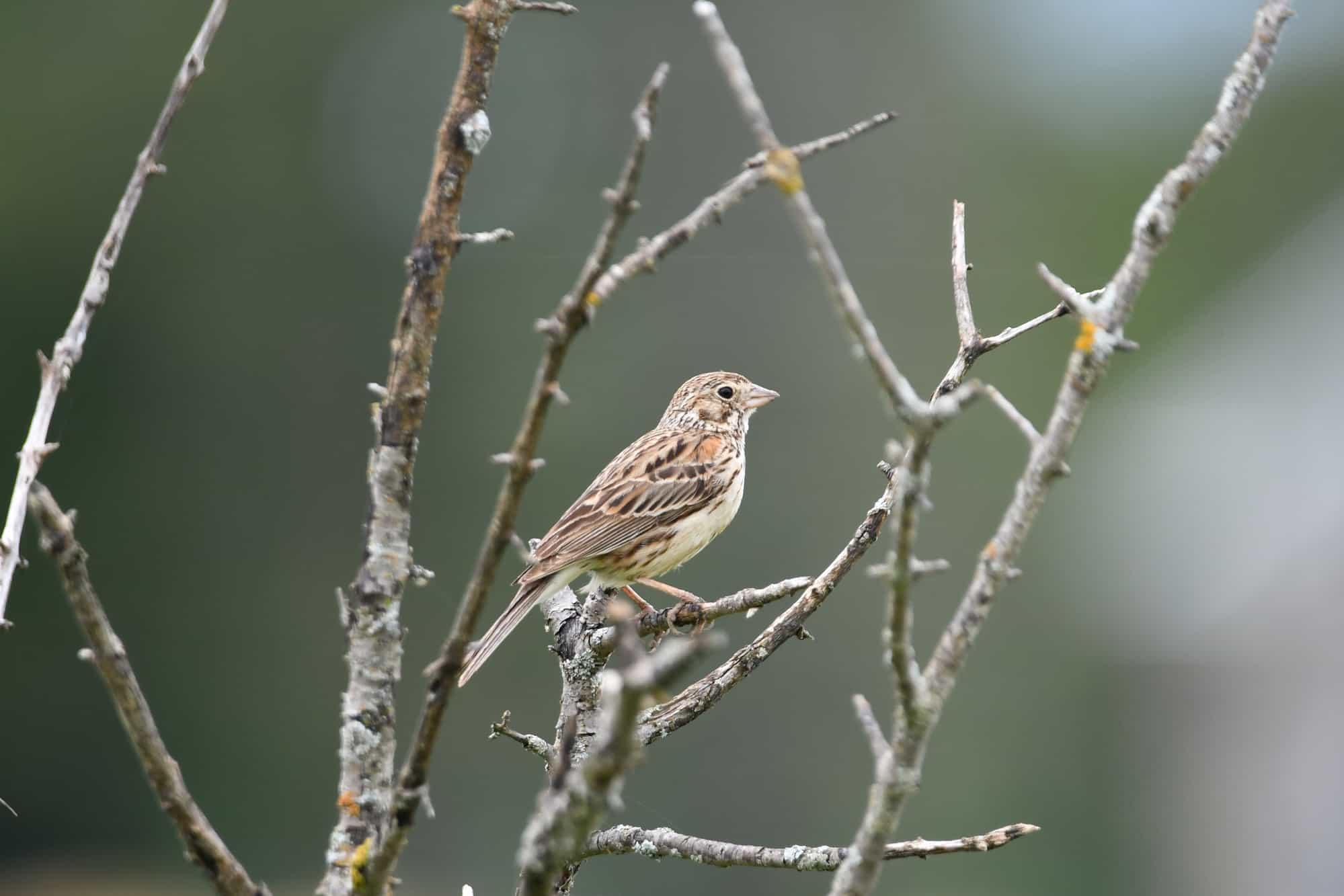
- Scientific Name: Pooecetes gramineus
- Length: 5.1-6.3 in (13-16 cm)
- Weight: 0.7-1.0 oz (20-28 g)
- Wingspan: 9.4 in (24 cm)
The vesper sparrow is similar in appearance to the savannah sparrow, but they’re slightly larger, with a longer tail, and without the yellow wash on their face. Like their cousins, they can often be seen perching in the open on wire fences, and typically fly to treetops when disturbed.
Although they’re more common in the west of the country, vesper sparrows are a fairly rare sighting in Michigan. Small numbers of them can be found throughout the state during the summer when they nest in extensive grasslands. In winter, they return to the Southern US and Central America.
Over the last 50 years, Vesper sparrow populations have dramatically declined by 37%. This is mostly due to habitat loss in both breeding and wintering grounds. Modern farming practices, including pesticide use, hedgerow clearing, and early hay harvesting have sadly proved detrimental.
Lincoln’s Sparrow
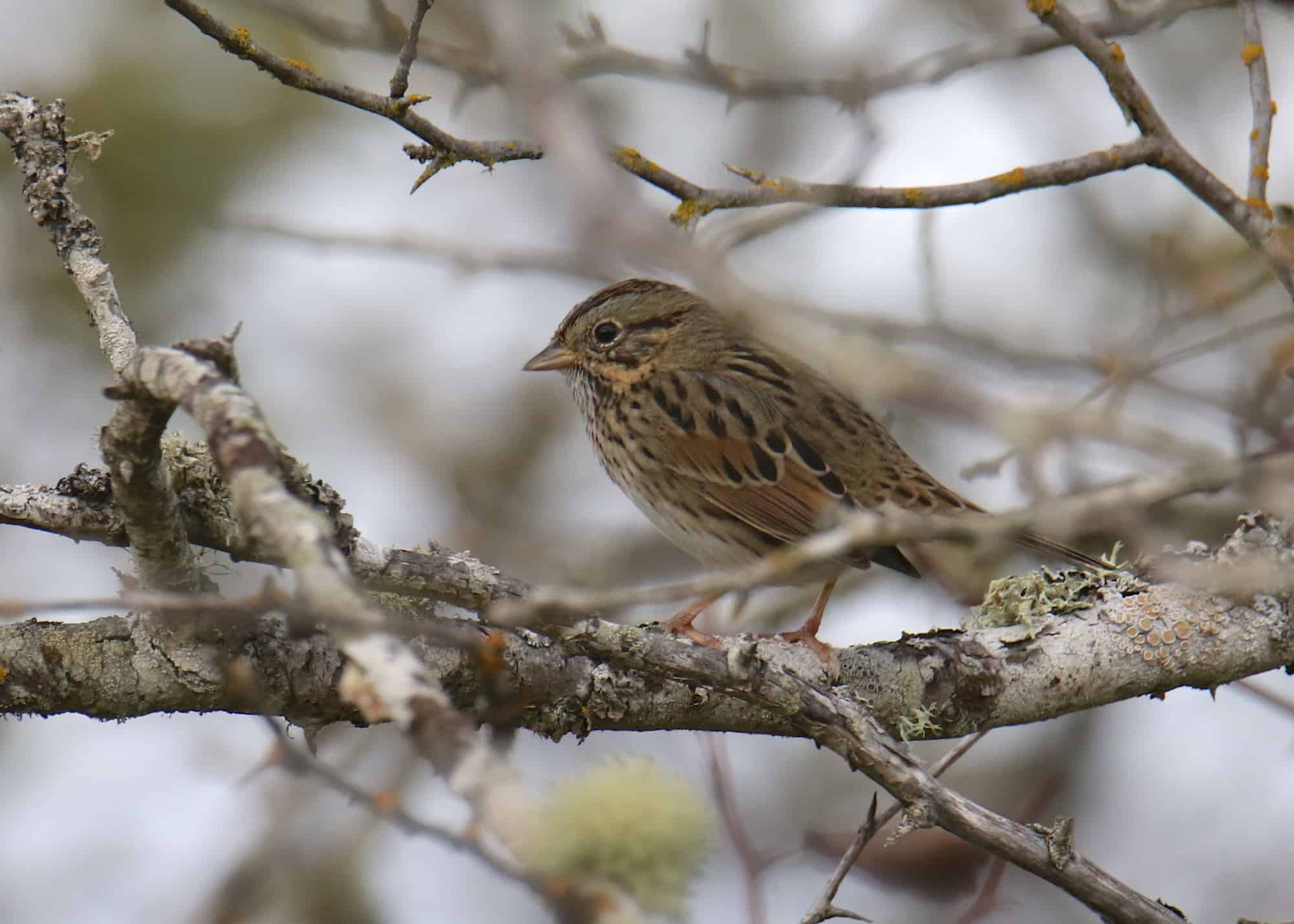
- Scientific Name: Melospiza lincolnii
- Length: 5.1-5.9 in (13-15 cm)
- Weight: 0.6-0.7 oz (17-19 g)
- Wingspan: 7.5-8.7 in (19-22 cm)
Lincoln’s sparrows might be fairly difficult to recognize by sight but are easily identified by their song which is surely one of the sweetest and most therapeutic of any sparrow in North America.
You’ll only find Lincoln’s sparrows in the northern half of Michigan during the breeding season. These rather secretive birds like to nest in damp habitats, often in sunny clearings among alder and willow thickets, or at the margins of bogs.
In the rest of the state, your only chance of seeing or hearing them is during the bi-annual migration seasons.
Clay-colored Sparrow
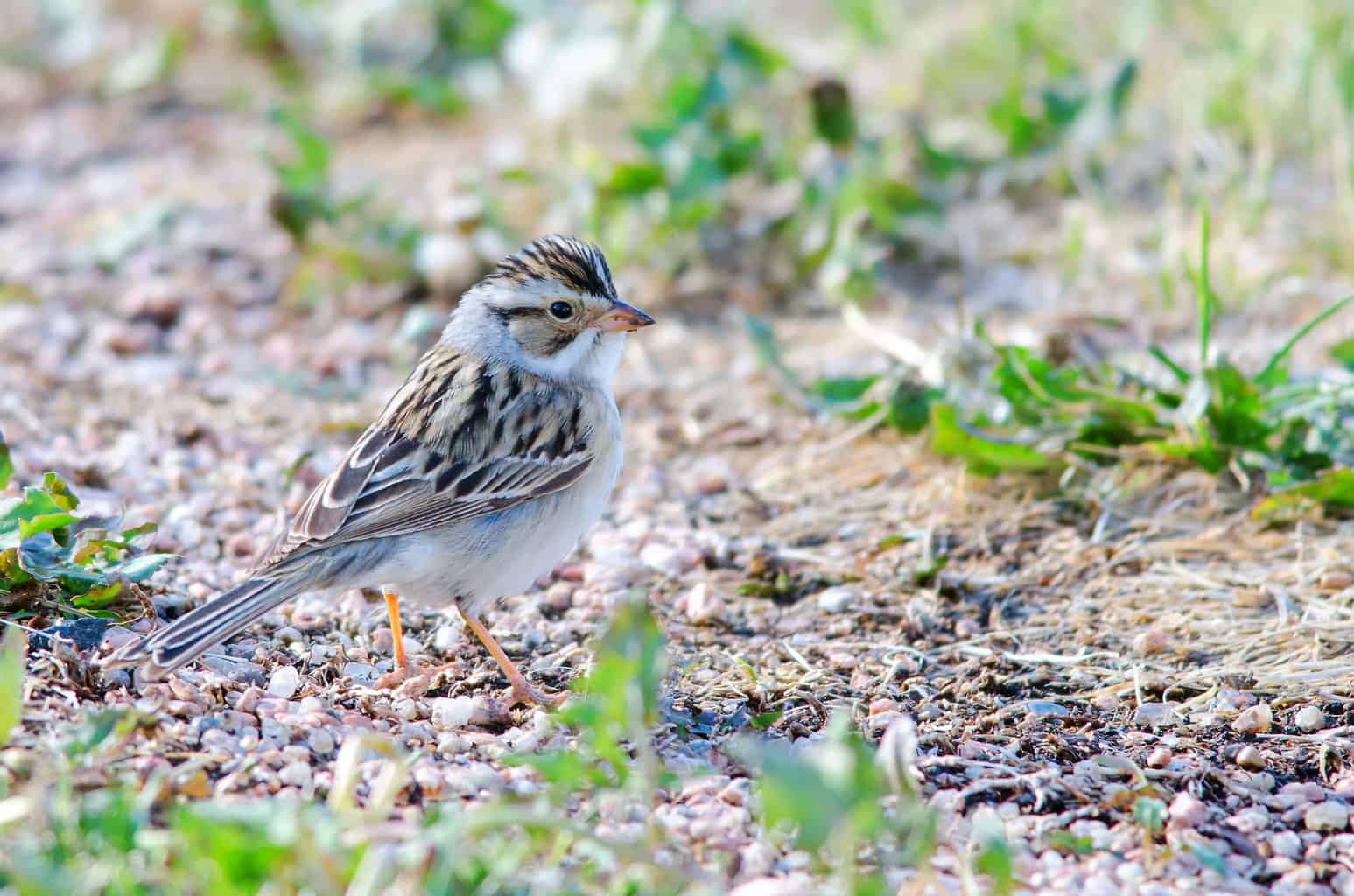
- Scientific Name: Spizella pallida
- Length: 5.1 – 6 in (13 – 15 cm)
- Weight: 0.42 oz (12 g)
- Wingspan: 7.5 in (19 cm)
The clay-colored sparrow mostly spends its winters in Central America and is only a migratory species in the vast majority of the USA.
In Michigan, however, they can be found nesting near the ground in the northern half of the state during the summer. The young leave the nest before they can fly and simply have to run from danger when threatened.
It’s during the breeding season that the clay-colored sparrow is rather undeserving of its name! Between April and August, it has a white underside, rather than the pinkish-brown colored underside that defines these birds during the winter.
Still, this white underside is enough to differentiate it from its cousin – the more grayish chipping sparrow.
Grasshopper Sparrow
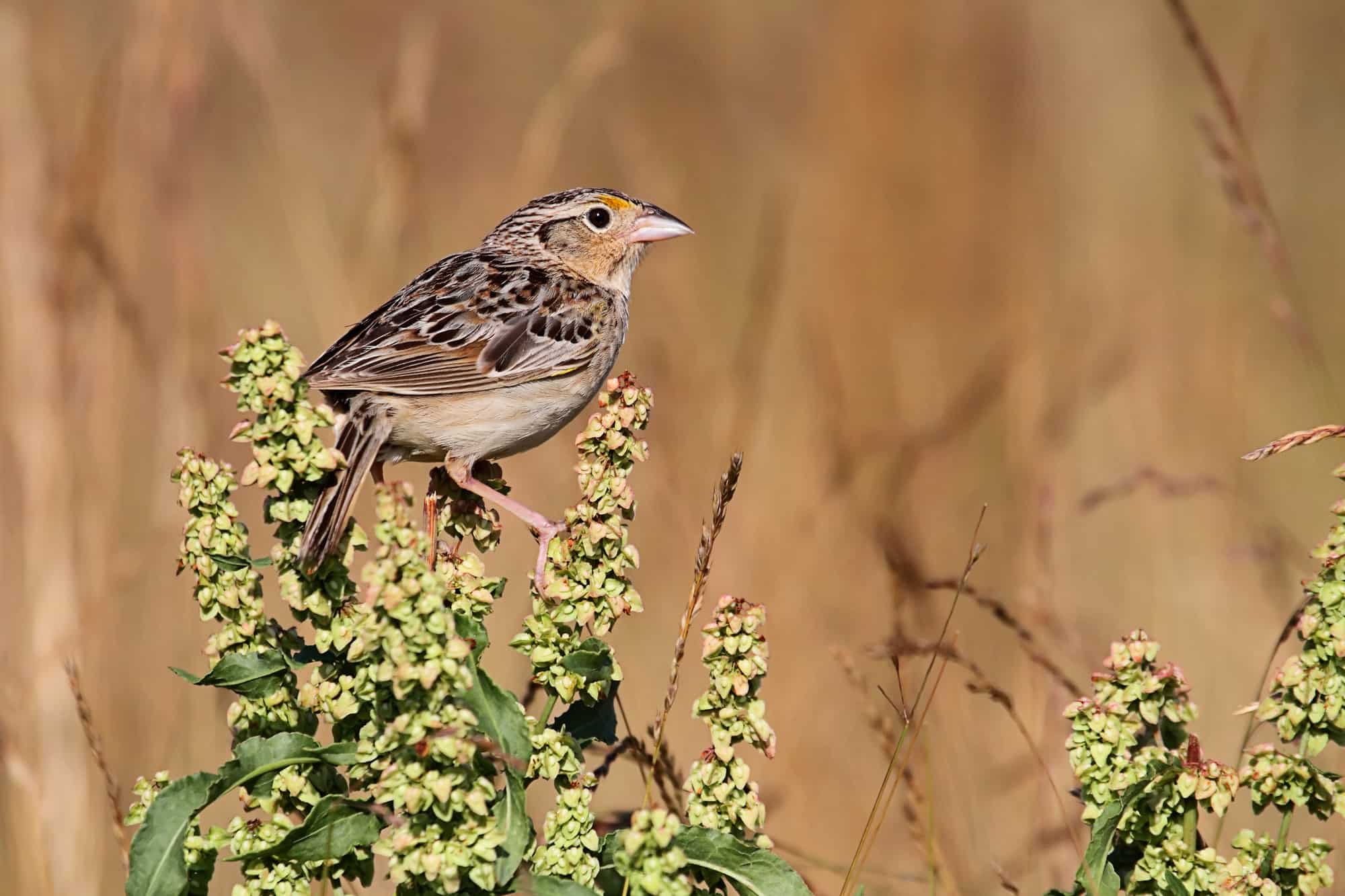
- Scientific Name: Ammodramus savannarum
- Length: 4.3-4.5 in (10.8-11.5 cm)
- Weight: 0.5-0.7 oz (14-20 g)
- Wingspan: 7.9 in (20 cm)
Grasshopper sparrows are the most widespread members of the Ammodramus clan of sparrows, a group of rare, tiny, shy birds that are normally found in grasslands. It can be told apart from its cousins by the lack of streaks on its breast that are present in other species.
The grasshopper sparrow not only sounds like a grasshopper but also loves feeding on them during the summer when they nest in dry grasslands. Learning this call is one of the best ways to glimpse this secretive bird – a good pair of binoculars is fairly essential if you want to enjoy observing them!
Summer is the only time of year when you’ll find grasshopper sparrows in the south of Michigan – these warmth-loving birds spend their winters only in the Southernmost United States and Central America.
Henslow’s Sparrow
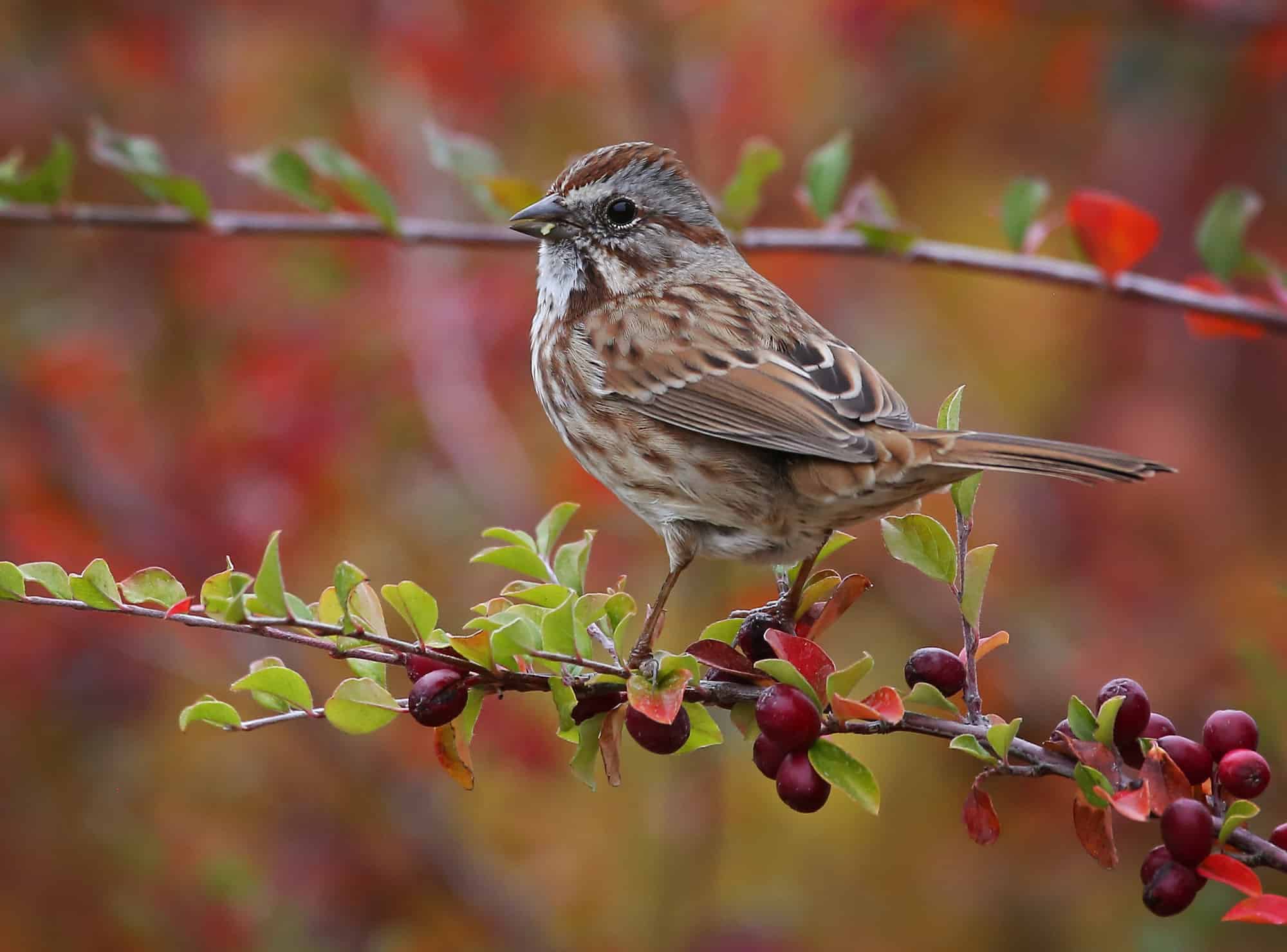
- Scientific Name: Centronyx henslowii
- Length: 4.75 – 5.25 in (12 – 13 cm)
- Weight: 0.5 oz – (14 g)
- Wingspan: 6-7 in – (15 – 18 cm)
An even tinier cousin of the grasshopper sparrow, Henslow’s sparrow is one of the smallest of all sparrows in North America. They can be recognized by their short tail, large yellowish head, and heavy bill.
Henslow’s sparrows are a rare species that can only be found in the southern half of Michigan during the breeding season. They are entirely absent from the upper peninsula, and spend their winters in the southeastern fringes of the US.
Since Henslow’s sparrow is so rare and well-camouflaged, it should be considered prized spotting. Like its relatives, its song sounds rather like an insect, but they are normally found in wetter habitats than the grasshopper sparrow.
LeConte’s Sparrow
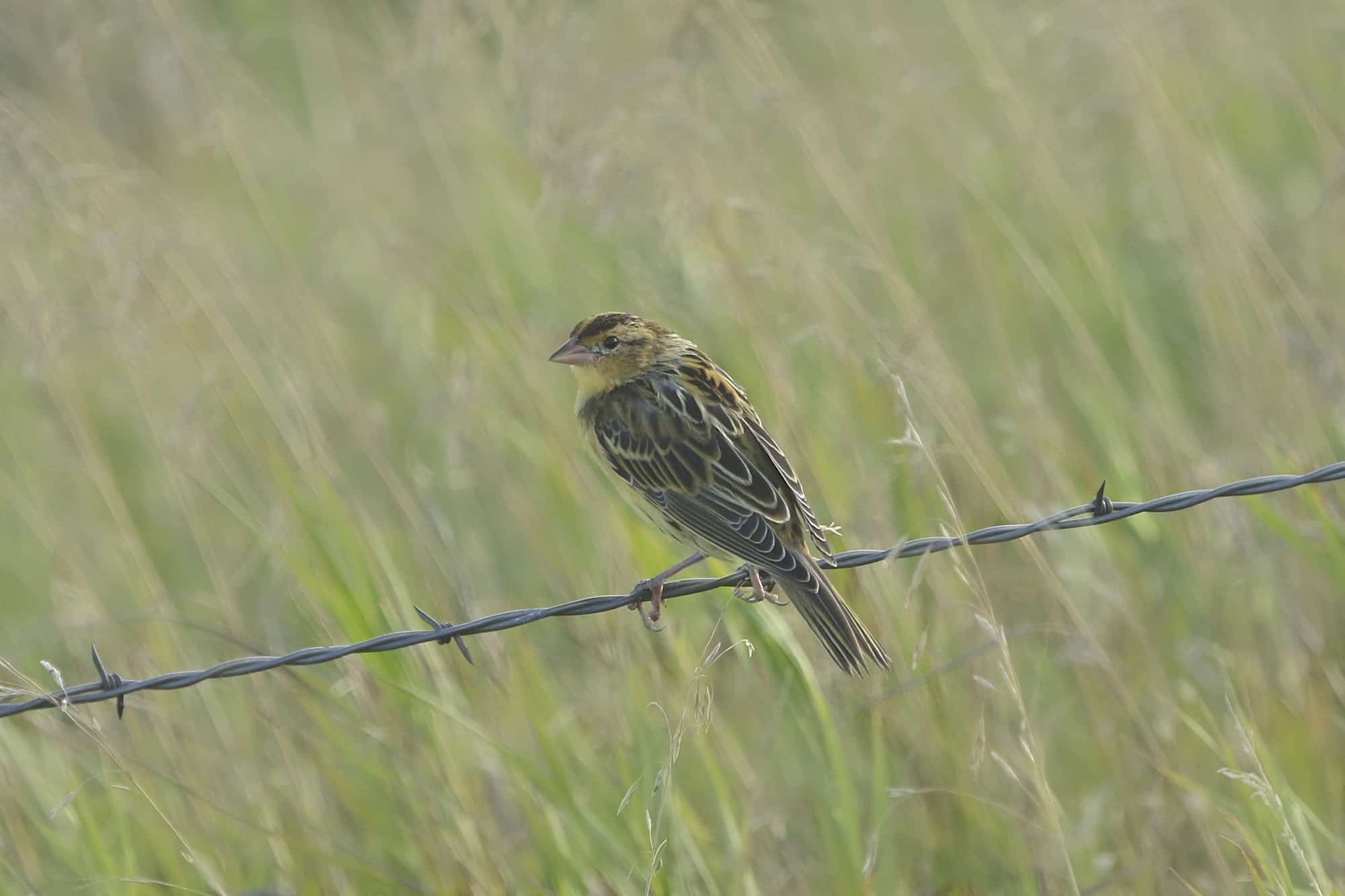
- Scientific Name: Ammospiza leconteii
- Length: 4.7-5.1 in (12-13 cm)
- Weight: 0.4-0.6 oz (12-16.3 g)
- Wingspan: 6.3-7.1 in (16-18 cm)
Very similar to, but even rarer than Henslow’s sparrow is LeConte’s sparrow.
Another tiny bird of wild, grassy habitats, but this bird prefers even wetter habitats than Henslow’s sparrow. It can be told apart from its relatives by the crisp, dark streaks on its flanks and also by its smaller bill.
Luckily, this species can also be distinguished by its distribution in Michigan. According to the Sibley Guide to Birds, it breeds exclusively in the upper peninsula of Michigan, where neither grasshopper sparrows, nor Henslow’s sparrow can be found.
- Sibley Guide To Birds, 2nd Ed
- Sibley, David Allen (Author)
- English (Publication Language)
Last update on 2024-07-26 / Affiliate links / Images from Amazon Product Advertising API
Its secretive nature makes it difficult to spot, although Le Conte’s sparrow can occasionally be seen perching on the tops of shrubs and weeds. According to bird watchers’ reports, this species is only seen by one in a thousand bird watchers in Michigan!
Sparrows That Can Be Found in Michigan During Migration
As well as the 17 species that take up residence in Michigan at different times of the year, there are a couple of species that merely pass through the state on their way to and from their northerly breeding grounds.
By far the most commonly seen of these two species is the Taiga subspecies of fox sparrow (Passerella iliaca). These large, reddish, speckled sparrows overwinter in the southeastern United States and fly north to breed in the Canadian and Alaskan tundra during the summer.
The other migratory species that occasionally make an appearance in Michigan is the unmistakable Harris’s sparrow (Zonotrichia querula).
The black cap and throat of this distinctive bird make it easy to identify even from a distance, but their migration routes are typically further west than Michigan. Occasionally mixing with flocks of white-throated sparrows, they can be considered a prized spotting this far east!
Michigan Sparrows Summary
The cold winters in Michigan are enough to discourage all but the most hardy sparrow species, but the state is a great place to see sparrows during the breeding season.
Whether you’re watching house sparrows building their nest in the eaves of your house, or tracking down an extremely rare Le Conte’s sparrow in the marshy wetlands, Michigan offers an array of opportunities to get closer to these endearing birds.
Sparrows are only a tiny part of the huge wealth of bird species in Michigan. The Great Lake State is also home to Evening Grosbeaks, Green Herons, and Snowy Owls and you can find out more about all of them in our birder’s guide to Michigan here.

